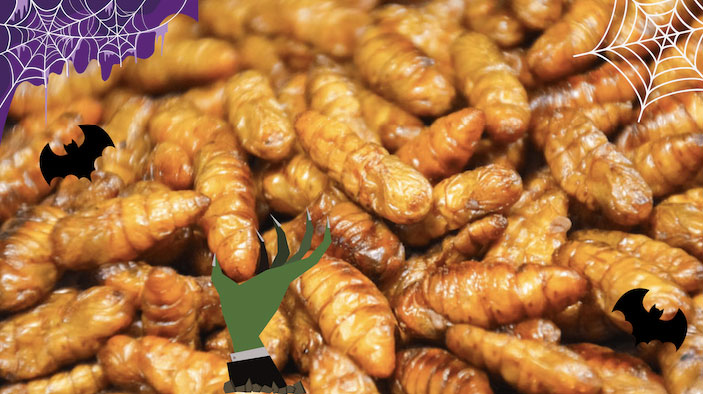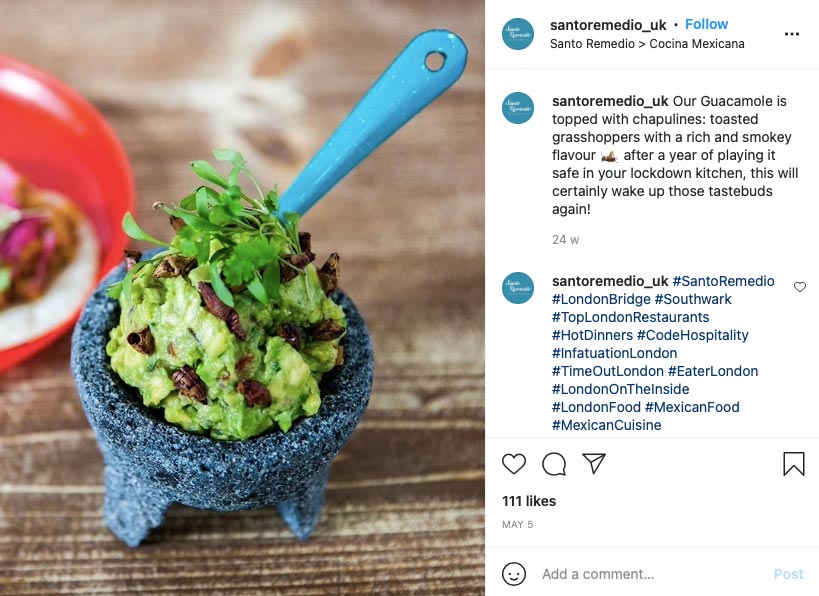Once upon a time, Halloween was all about donning your favourite costume, enjoying some apple bobbing, or testing out a new culinary creation with the seasonal delight that is the pumpkin.
While those experiences certainly have their charm, they might not capture the full eerie essence of Halloween. Fear not, for we have delved into some of the most spine-chilling culinary trends to bring you Halloween spooky food ideas to create a dining experience that embraces the spirit of the season.
Forget about your typical treats and venture into the world of crispy insects, grubs, brain patties, and more. Rest assured, it’s not only a daring experience but also a remarkably delicious one. Are you prepared to take the plunge into this culinary adventure?
If you enjoy this Halloween content, you might also enjoy our spooky blog about the scary food safety hazards to watch out for… Read it here. 🎃
Get the Creep Factor with Bugs and Grubs 🦗
Imagine a delectable menu featuring six-legged creatures and melt-in-your-mouth grubs. While the thought of consuming insects may seem peculiar, there’s more to them than meets the eye. In fact, some argue that they could play a pivotal role in addressing global hunger. Let’s explore how these critters can inject some excitement into your culinary offerings.

What Do Insects and Grubs Taste Like?
While the idea of insect-eating might be frightfully weird, you’d be surprised by their inclusion nowadays on many UK menus. The Grub Kitchen was the first restaurant dedicated to serving insects. Fancy a grub bolognese or a bug burger? We’ve also heard their famous cricket cookies are tasty too!
If you’re looking for the perfect flavour to get you involved in one of the creepiest food trends, here’s what’s been said:
- Crickets are associated with a nutty flavour 🌰
- Red ants are used as a creamy alternative with notes of sour lemon 🍋
- Beetles are the new popcorn alternative for movie nights 🍿
- Scorpions are close to crab and fishy flavours – ideal to replace seafood 🦀
- The giant water bug tastes like bananas and melons 🍌
- Sago grubs: fatty and melt in the mouth like your morning bacon 🥓
- Cockroach to replace chicken 🍗
- Black soldier fly larvae for blood pudding flavours 🩸
Let’s be honest, that’s enough flavours and textures to build a very elaborate meal! But how do you cook and prepare insects, you ask? You can grind crickets and turn them into protein-packed flour for baking, for example. Or try raw, sautéed, steamed, fried, refried, skewered: there’s so many options to experiment with. It’s your opportunity to concoct something unique!
Need some inspiration? Santo Remedio in London has a lovely guacamole flavoured by nutty notes of roasted grasshoppers.
The Benefits of Eating Insects
Insects are actually already being explored by several eco-friendly chefs as an alternative.
Indeed, they’re often a more local and sustainable alternative to meat. Firstly, crickets are made of up to almost 70% protein. So a single portion of crickets would fulfil between 25-60% of your daily requirement of protein. They also contain many essential minerals and vitamins such as iron (twice as much as in spinach!), potassium and B12. Plus, 5 times more magnesium than beef.
Secondly, insects are very accessible. Actually, about 2 billion people across the world are already eating insects on a daily basis, especially in Asia, Africa and Central America! Ready to join the entomophagists? Yes it has a name! Vampires, werewolves, vegans… and entomophagists! 🧛
Thirdly, it’s also great for the planet as insect farming requires vastly less resources and can be grown on a very large scale without damaging the environment. To put it into perspective, producing 1 kilogram of crickets consumes just 1 litre of water, while the equivalent amount of chicken demands a staggering 2,300 litres. It’s a startling revelation that underscores the benefits of this unconventional food source.
Still not convinced? Well you actually eat more than a pound of insects every year already anyway 😉. These are hidden in foods we consume daily without realising it! So think twice next time you devour your chocolate, dates, potatoes, broccoli and canned fruit juices…
Insects and Food Safety
The mealworm was the first insect to have officially been declared safe to eat by the European Foods Safety Agency early 2021. But what about everything else?
Like any other food, manipulating edible insects should follow strict hygiene routines during harvesting, handling and cooking. Insects are much more common in Asian and South American kitchens. But very few laws currently exist in Western cultures for insects and prevention of microbiological and chemical risks.
In addition, there isn’t any labelling rules either on insect-based foods. But here’s a few food safety concerns that the Food and Agriculture Organization of the United Nations (FAO) has raised about insects:
- Allergenic risks: anyone allergic to seafood should probably avoid insects to be safe. Indeed, insects and crustaceans both belong to the same arthropod family known for severe allergic reaction and so allergen cross-reactivity could be possible.
- Biological risks: bacteria such as E.coli and Campylobacter and other fungi and parasites can be present in insects.
- Chemical risks: because insects are eaten as a whole rather than in “bits”, it makes them vulnerable to chemical contamination with pesticides and toxic metals.
- Physical risks: choking hazard due to little parts, such as wings, spines and stingers.
As no regulations actually exist regarding insects, what can you do? Just follow classic food hygiene routines:
- First, always wash raw insects and anything else you’ve touched after manipulating raw insects (utensils, surfaces, handles, cloths).
- Second, separate raw insects from other food to avoid cross contamination. Make sure you use different knives, utensils and chopping boards.
- Third, cook your insects thoroughly – whether sautéed or fried, ensure they’re cooked through.
- Finally, don’t leave your insects out on the kitchen counter – any leftovers should be quickly refrigerated to avoid bacteria growth.

The World of Organ Meats 🫀
But what about organ meats, you may wonder? Organs like brains, eyeballs, and livers, often depicted as the stuff of nightmares, are right within your reach and can make for truly intriguing dishes.
If haggis (comprising sheep’s heart, liver, and lungs) doesn’t quite suit your palate, there are other recipes that may pique your interest. Have you ever fancied indulging in a brain burger?
What Do Organ Meats Taste Like?
TruBeef provides a great guide to cooking organ meat and the different qualities of each type. But the general consensus is that organ meat ranges from tasteless – like a chicken breast, the perfect base for a marinade or seasoning, to similar to the rest of the meat from the animal it comes from – like cow tongue and other cuts of beef.
It’s not always the initial taste that attracts a chef to organ meat, as that is typically adapted throughout the culinary process. Often, the texture of organ meats is the main appeal.
MEATliquor advises their customers to “come hungry, leave wobbly” for their organ offering. Their chefs cook brain for its unique texture, creating both moist, soft and crispy textures. You can poach, grill, roast or batter brains to send your tastebuds to new – frightening – heights. It can get quite liquid-y though, so be ready to get out of your comfort zone.
If brains aren’t your thing, let your heart pump to new flavours with Ceviche’s heart recipe ‘Anticucho de Corazon’ – i.e. marinated beef heart.
Fancy a full body discovery? Head to Barrafina in London to be served by the H(e)art brothers. A unique bloody tapas night to awaken your darker senses with calf’s liver and roasted veggie skewers, calf tongue, kidney and brains.
The Nutritional Advantages of Organ Meats
The reality is, organ meats are packed with nutrients that many health practitioners would recommend.
Western societal conventions have made our diets very restricted to select meats. The meat that we currently consume has its fat removed – while we reject nutrient-rich organs that instead go to waste.
Organ meat is one of the most nutrient-dense food available on the planet, meaning you’re getting so many vitamins and minerals all at once and naturally, rather than via supplements. Vitamins A, B, D, E, copper, zinc, iron, magnesium, selenium – everything you need to supercharge yourself. So ditch muscle meat, go deeper and reach the organs. What a fangtastic idea! 🧠🫀
Cooking Organ Meats: Ensuring Safety
Follow the same rules as muscle meat when it comes to organ meats:
- Before and after manipulating raw offals, wash your hands and disinfect any utensils, surface, recipients and sinks that could have been contaminated.
- Make sure to separate raw offals from ready-to-eat foods.
- In addition, store organ meats on a lower shelf in the fridge to prevent leaks to contaminate other foods.
- In terms of cooking, ensure it’s cooked through to avoid bad bacteria and food poisoning with undercooked offals – typically campylobacter.
Also ensure you are using organ meat that is okay to eat. Human and squirrel brains aren’t recommended as they’ve been associated with neuro-degenerative diseases and potential mad cow illnesses. Organ meat is also extremely perishable so you’ll have to cook it quick. Buy your organ meat fresh and use within 24 hours to stay on the safe side.
As a little special treat (no trick – promise!) we have gathered some extra tips from an expert in cooking organ meats:
- Don’t forget to soak your brain meat in water or milk to drain all the blood to give your organ meat a better taste. To go faster, change the soaking liquid frequently.
- Give them a good wash and soak to ensure you haven’t left any bone fragments in – a key health hazard that could cost you a few points in an inspection or a bad review from your customers!

Discover Blood-Based Dishes 🩸
What about blood then? Blood is another element that can send shivers down the spine, but it’s worth exploring its culinary potential.
While you might have encountered blood-based dishes like black pudding, chefs have taken innovation to new heights by using blood as a substitute for eggs in various recipes. To use blood effectively in cooking, chefs employ specific techniques and ingredients to eliminate its metallic taste and create unique culinary experiences.

What Does Blood Taste Like?
By combining blood with chocolate and spices, the metallic taste is removed.
Some chefs like to use blood as an egg substitute due to its high protein content and similar coagulating and emulsifying properties in cooking and baking. Actually, this is a good alternative for individuals with egg allergies. Keep in mind that egg allergies rank as the second most common food intolerance among children in Europe.
Using blood can also aid in addressing iron deficiency and tackling anaemia, as it provides a rich source of iron. Blood meringue, anyone? 🩸 Its distinctive colour will always add a spooktacular touch to your menu too.
Blood has always been controversial and still is. It is less of a taboo in some Asian cultures where blood soups are common but isn’t quite mainstream in our Western cultures.
However, some European chefs have started breaking boundaries and taboos of blood-based cooking to craft recipes made with blood. For example, blood tarts with figs and blood custard with pickled pears, or even blood-chocolate pudding with cherries. Don’t forget to whip the blood enough to remove all the clots…
Safely Incorporating Blood into Your Dishes
Ready to swap your classic egg batter for a much creepier thickener? Here’s how to stay safe when using blood in your recipes:
When handling your blood, keep following the classic hygiene routines that you would use when handling raw food. Dedicate preparation areas and storage areas, disinfect any surface or utensils that were used when handling fresh blood.
On top of that, to ensure fresh and safe food for your customers, carefully choose your blood supplier – not your nasty local vampire! For example, if you are to purchase pig’s blood, check that it is certified as “edible” which means it has been checked and the blood is coming from a healthy animal. Indeed, this will mean it was inspected ante- and post-mortem. Pig blood also must come from a country free of swine fever. You don’t want your food business to make the next big headline with a new illness outbreak.
Finally, similarly to meat, cook thoroughly to avoid any other bacteria contamination. Raw blood just isn’t a thing. If you use it in your next bloody chocolate brownie for extra thrills, do so safely.
- Make sure to add your blood handling hazard checks in your HACCP.
- Trace the blood from supplier to plate to protect your business.
- Fresh blood should be stored hygienically at a temperature of 3°C or less.
Halloween Creepy Food Ideas:
Our Menu Suggestions
Looking for some inspiration to add some of these creepiest food trends?
Here’s our inspirational Halloween, thrills-guaranteed menu:
Starter: Heart-warming beef heart meatloaf muffins. Too cute to spook right?
Main: Golden crisp deep fried tarantula and its cracking worm meal slaw.
Dessert: Creep it real with a Crawling Cricket Cobbler.

But don’t forget: as you venture into these unconventional and spine-chilling food trends, it’s essential to prioritise food safety and maintain the highest standards of hygiene. Be safe out there while trying your Halloween creepy food ideas!
If you need help with your safety processes, speak to a member of our safety team who will be able to advise you on how to operate safely.
Subscribe for more safety content updates:








